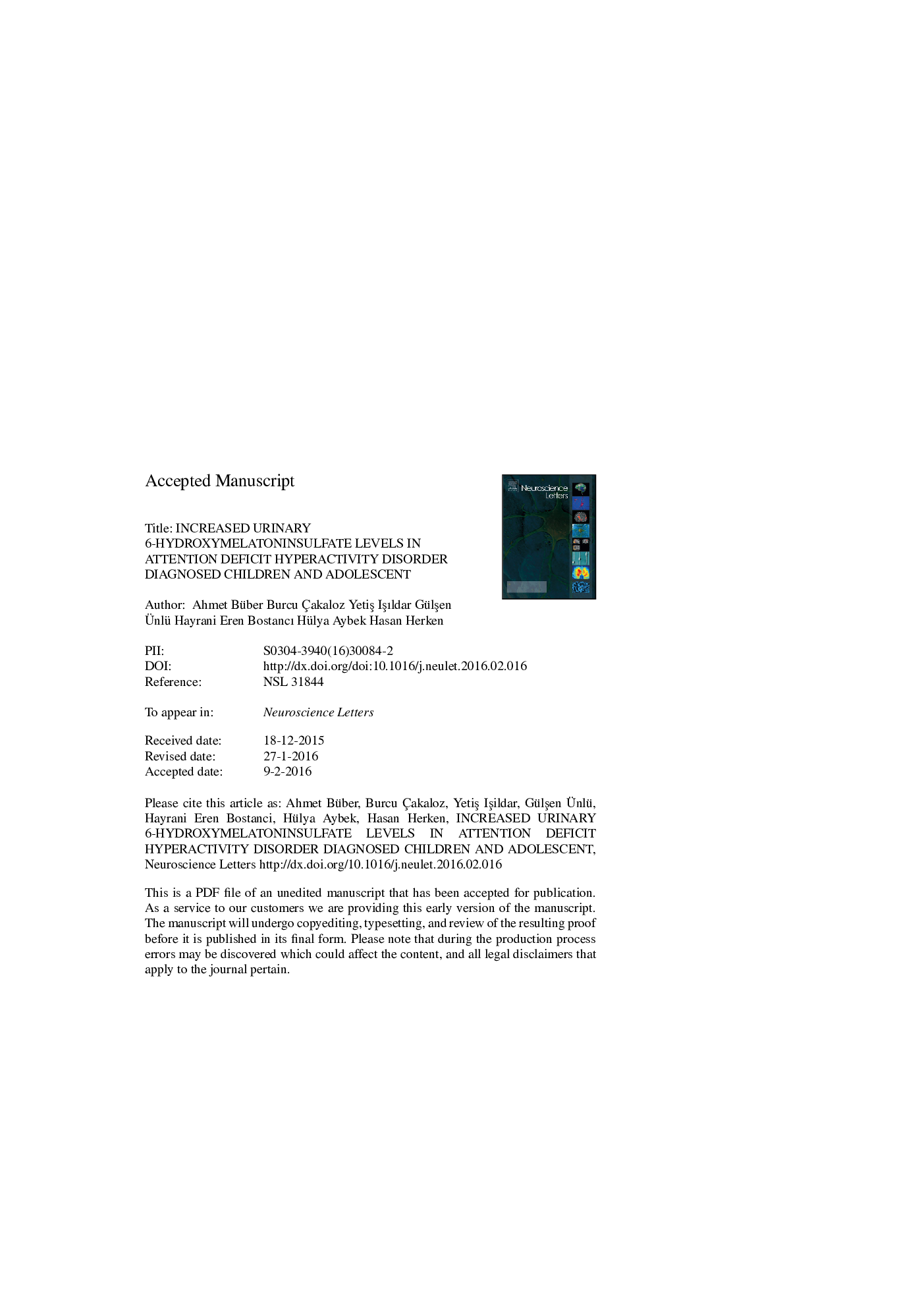| کد مقاله | کد نشریه | سال انتشار | مقاله انگلیسی | نسخه تمام متن |
|---|---|---|---|---|
| 6279967 | 1615082 | 2016 | 18 صفحه PDF | دانلود رایگان |
عنوان انگلیسی مقاله ISI
Increased urinary 6-hydroxymelatoninsulfate levels in attention deficit hyperactivity disorder diagnosed children and adolescent
ترجمه فارسی عنوان
افزایش میزان ادرار 6-هیدروکسی ملاماتون سولفات در کودکان مبتلا به اختلال بیش فعالی کمبود توجه کودکان و نوجوانان
دانلود مقاله + سفارش ترجمه
دانلود مقاله ISI انگلیسی
رایگان برای ایرانیان
کلمات کلیدی
ملاتونین، اختلال بیش فعالی کمبود توجه، 6-هیدروکسی ملاماتون سولفات، ریتم شبانه روزی، کودک، نوجوانان
موضوعات مرتبط
علوم زیستی و بیوفناوری
علم عصب شناسی
علوم اعصاب (عمومی)
چکیده انگلیسی
There are some studies in attention deficit hyperactivity disorder (ADHD) which note altered circadian rhythms, suggesting abnormalities in melatonin physiology. In order to better characterize the possible melatonin alteration in ADHD, in this study we aimed to detect daytime, nighttime and 24 h levels of 6-hydroxymelatoninsulfate (6-OH MS) in the patients diagnosed with ADHD. Twenty-seven patients between 6 and 16 years-old, who had been diagnosed initially with ADHD, but without other physical and psychiatric disease history and who had not taken psychotropic pharmacotherapy for six months, plus 28 healthy volunteer controls, were included in the study. Urine samples were collected during the whole 24 h cycle, daytime and nighttime separately to assess the time-dependent excretion of the 6-OH MS, which is the main urine metabolite of melatonin. The Enzyme-Linked Immunosorbent Assay (ELISA) method was used for measuring the urine 6-OH MS level. Daytime (15.4 (8.9-24.8) ng/ml vs 6.9 (2.5-15.9) ng/ml, p = 0.002), nighttime (102.9 (65.3-197.7) ng/ml vs 61.5 (37.2-114.4) ng/ml, p = 0.012) and 24 h (54.1 (34.6-83.9) ng/ml vs 27.3 (14.3-48.9) ng/ml, p = 0.000) 6-OH MS levels median (25p-75p) were found to be significantly higher in the ADHD group. After adjustment for age and sex, there was a statistically significant difference between the ADHD group (59.8 ± 4.9) and control group (33.8 ± 4.8) in 24-h 6-OH MS levels (F(1, 51) = 13.673, p = .001, partial η2 = .211). There was no relationship between 6-OH MS levels and Conners Parent Rating Scale short form subscale scores for the ADHD group. These findings indicate that melatonin production is increased in ADHD cases. Further research is needed to determine and thereby understand the mechanisms underlying the higher melatonin production, to assess the impact of altered melatonin on the pathophysiology of ADHD.
ناشر
Database: Elsevier - ScienceDirect (ساینس دایرکت)
Journal: Neuroscience Letters - Volume 617, 23 March 2016, Pages 195-200
Journal: Neuroscience Letters - Volume 617, 23 March 2016, Pages 195-200
نویسندگان
Ahmet Büber, Burcu Ãakaloz, YetiÅ IÅıldar, GülÅen Ãnlü, Hayrani Eren Bostancı, Hülya Aybek, Hasan Herken,
